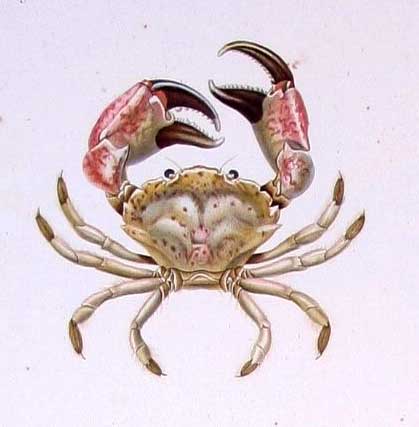
Superregnum: Eukaryota
Cladus: Unikonta
Cladus: Opisthokonta
Cladus: Holozoa
Regnum: Animalia
Subregnum: Eumetazoa
Cladus: Bilateria
Cladus: Nephrozoa
Cladus: Protostomia
Cladus: Ecdysozoa
Cladus: Panarthropoda
Phylum: Arthropoda
Subphylum: Crustacea
Superclassis: Multicrustacea
Classis: Malacostraca
Subclassis: Eumalacostraca
Superordo: Eucarida
Ordo: Decapoda
Subordo: Pleocyemata
Infraordo: Brachyura
Sectio: Eubrachyura
Subsectio: Heterotremata
Superfamilia: Xanthoidea
Familia: Panopeidae
Genera: Acantholobulus – Chasmophora – Cycloplax – Dyspanopeus – Eucratopsis – Eurypanopeus – Eurytium – Glyptoplax – Hexapanopeus – Homoioplax – Lithopanopeus – Lophopanopeus – Malacoplax – Metopocarcinus – Milnepanopeus – Neopanope – Odontoplax – Panopeus – Prionoplax – Rhithropanopeus – Tetraplax
The Panopeidae are a family containing 26 genera of morphologically similar crabs, often known as "mud crabs". Their centers of diversity are the Atlantic Ocean and eastern Pacific Ocean.
Distribution
Most members of the family Panopeidae live in the Atlantic Ocean or eastern Pacific Ocean. Only one species occurs in Australian waters – Homoioplax haswelli.[2]
Ecology
The various genera of the Panopeidae are morphologically similar, partly as a result of many instances of convergent evolution to similar habitats and food preferences.[3]
Crabs of the family Panopeidae are all free-living (not commensal or parasitic),[2] and typically live in soft-bottomed parts of the ocean,[3] lending them the common name "mud crabs" (a name also shared by other organisms). They burrow into the sediment and feed on a variety of marine invertebrates.[3]
Genera
The World Register of Marine Species lists these subfamilies and genera:[1]
Eucratopsinae Stimpson, 1871
Chasmophora Rathbun, 1914
Cycloplax Guinot, 1969
Cyrtoplax Rathbun, 1914
Eucratopsis Smith, 1869
Glyptoplax Smith, 1870
Homoioplax Rathbun, 1914
Malacoplax Guinot, 1969
Odontoplax Garth, 1986
Panoplax Stimpson, 1871
Prionoplax H. Milne-Edwards, 1852
Robertsella Guinot, 1969
Tetraplax Rathbun, 1901
Thalassoplax Guinot, 1969
Panopeinae Ortmann, 1893
Acantholobulus Felder & Martin, 2003
Dyspanopeus Martin & Abele, 1986
Eurypanopeus A. Milne-Edwards, 1880
Eurytium Stimpson, 1859
Hexapanopeus Rathbun, 1898
Lithopanopeus Felder & Thoma, 2020[4]
Lophopanopeus Rathbun, 1898
Lophoxanthus A. Milne-Edwards, 1879
Metopocarcinus Stimpson, 1860
Neopanope A. Milne-Edwards, 1880
Panopeus H. Milne-Edwards, 1834
Rhithropanopeus Rathbun, 1898
Tetraxanthus Rathbun, 1898
References
Davie, P. (2015). "Panopeidae Ortmann, 1893". WoRMS. World Register of Marine Species. Retrieved 2015-07-03.
P. J. F. Davie (2002). "Panopeidae". Crustacea: Malocostraca: Eucarida (Part 2), Decapoda: Anomura, Brachyura. Zoological Catalogue of Australia. Vol. 19. Canberra, Australia: CSIRO Publishing. pp. 372–374. ISBN 978-0-643-06792-9.
C. D. Schubart, J. E. Neigel & D. L. Felder (2000). "Molecular phylogeny of mud crabs (Brachyura: Panopeidae) from the northwestern Atlantic and the role of morphological statis and convergence" (PDF). Marine Biology. 137 (1): 11–18. doi:10.1007/s002270000325.
Felder, Darryl L.; Thoma, Brent P. (2020-09-03). "A new genus and species of mud crab (Crustacea, Brachyura, Panopeidae) from shoreline waters of the western Gulf of Mexico". Zootaxa. 4845 (3): 425–435. doi:10.11646/zootaxa.4845.3.7. ISSN 1175-5334.
Retrieved from "http://en.wikipedia.org/"
All text is available under the terms of the GNU Free Documentation License

